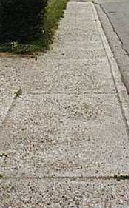Time-Tested Performance
 Modern times have brought modern challenges – even when working with age-old materials such as metals and concrete. Deterioration of building materials is becoming a serious problem for cities and towns. The effects of weathering are more severe due to pollutants introduced into the atmosphere. Buildings, roadways, curbs and sidewalks are all subject to this new phenomenon. Atmospheric pollution is a major cause of concrete deterioration, especially in industrial areas. Sulfur dioxide in the air combines with rainwater to form sulfurous acid. This reacts with lime compounds in the concrete, forming Calcium Sulfate. Calcium Sulfate is only slightly soluble in water and is deposited on or near the surface, forming a skin. The Calcium Sulfate then crystallizes behind this skin, and differential movements between it and the concrete underneath, loosen the concrete and cause disintegration.
Modern times have brought modern challenges – even when working with age-old materials such as metals and concrete. Deterioration of building materials is becoming a serious problem for cities and towns. The effects of weathering are more severe due to pollutants introduced into the atmosphere. Buildings, roadways, curbs and sidewalks are all subject to this new phenomenon. Atmospheric pollution is a major cause of concrete deterioration, especially in industrial areas. Sulfur dioxide in the air combines with rainwater to form sulfurous acid. This reacts with lime compounds in the concrete, forming Calcium Sulfate. Calcium Sulfate is only slightly soluble in water and is deposited on or near the surface, forming a skin. The Calcium Sulfate then crystallizes behind this skin, and differential movements between it and the concrete underneath, loosen the concrete and cause disintegration.
The highest concentration of sulfur dioxide in the atmosphere is in industrial areas. Polluted air causes erosion, and surfaces are weathered away, leaving coarse exposed aggregate highly susceptible to deterioration. Spalling due to corrosion of the reinforcement can also occur.*
*Compression strength (surface coat only). Results: +15% at 8 days; +23% at 31 days
SEAL-IT Concrete Sealant fills the pores in the concrete over an inch deep forming a barrier. This stops the rainwater, which carries the sulfur dioxide, from penetrating the pores of the concrete and prevents the formation of Calcium Sulfate.
 SEAL-IT Concrete Sealant provides denser, stronger concrete that will resist chemical attack at the surface, protecting the more vulnerable concrete inside.
SEAL-IT Concrete Sealant provides denser, stronger concrete that will resist chemical attack at the surface, protecting the more vulnerable concrete inside.
*ASTM-C-67 – Section 13. Results: 25% decrease in absorption.
*Credited to Concrete Materials and Practice Fifth Edition
